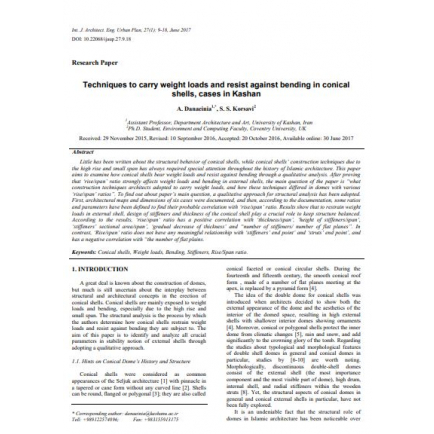
The relationship between architecture and symmetry in persian architecture – a case study of sheikh loṭfollāh mosque in isfahan
Date Added
22/07/2022
Content Type
Documentary
Category
Researches
Link to Content
Subject Area
Architecture and Interior
Author
Ahmad - Danaeinia
Mohammad Fattahpour
Publisher Name
Int. J. Architect. Eng. Urban Plan
Year of Publication
2018
Description
Little has been written about the structural behavior of conical shells, while conical shells’ construction techniques due to
the high rise and small span has always required special attention throughout the history of Islamic architecture. This paper
aims to examine how conical shells bear weight loads and resist against bending through a qualitative analysis. After proving
that ‘rise/span’ ratio strongly affects weight loads and bending in external shells, the main question of the paper is “what
construction techniques architects adopted to carry weight loads, and how these techniques differed in domes with various
‘rise/span’ ratios”. To find out about paper’s main question, a qualitative approach for structural analysis has been adopted.
First, architectural maps and dimensions of six cases were documented, and then, according to the documentation, some ratios
and parameters have been defined to find their probable correlation with ‘rise/span’ ratio. Results show that to restrain weight
loads in external shell, design of stiffeners and thickness of the conical shell play a crucial role to keep structure balanced.
According to the results, ‘rise/span’ ratio has a positive correlation with ‘thickness/span’, ‘height of stiffeners/span’,
‘stiffeners’ sectional area/span’, ‘gradual decrease of thickness’ and “number of stiffeners/ number of flat planes”. In
contrast, ‘Rise/span’ ratio does not have any meaningful relationship with ‘stiffeners’ end point’ and ‘struts’ end point’, and
has a negative correlation with “the number of flat plains.





